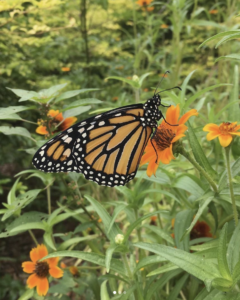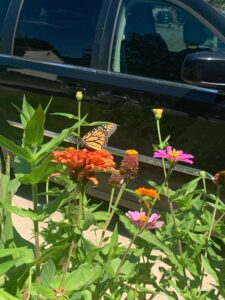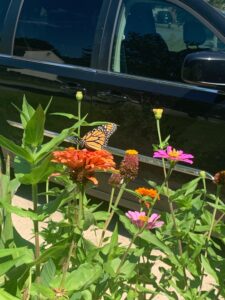The Butterfly Effect
When Zoo staff clock out for the day, you may assume that their duties are complete, but for two Zoo employees, Kylie Wash and Tara Baumgardner, this isn’t the case. Their passion for animals is carried off Zoo grounds, but the animals they spend time with at home aren’t your traditional cat, dog, hamster or even pet lizard, they’re something more peculiar – butterflies!
So how did Kylie and Tara enter the world of butterflies?
As a child, Kylie, the Zoo’s Camp and Overnight Program Coordinator, remembers raising these magnificent creatures with her mother, but she really got the itch to raise butterflies when the Butterfly Society of Virginia visited the Zoo to talk to our School’s Out Safari Campers.
“They brought in multiple species of butterflies and moths at different life stages for the campers to see, and they also brought milkweed seeds for campers and staff to plant in their own gardens. They taught us the basics of planting milkweed and I found my first monarch caterpillar on the plants this summer!”
As for our Program Animal Husbandry Coordinator Tara, it was her fiancé, who first expressed interest in raising butterflies. “He thought it was a way to enter ‘my world’ while doing our part in local conservation. He has a green thumb and loves horticulture and thought it would be fun to plant a butterfly garden.”
There are approximately 20,000 species of butterflies with about 725 of the species living in North America. Butterflies, along with their close cousin – the moth, belong to the insect group called Lepidoptera. While there are many species of butterflies, Tara and Kylie mostly raise and release Monarch butterflies.
Monarchs are one of the most recognized species of butterflies in North America. They have two sets of wings that are bright orange with a black border covered in white dots. The males have two black dots at the bottom center of their wings, making it easy to identify them from their female counterparts. Monarchs are broken into the eastern and western populations, and are geographically separated by the Rocky Mountains.
Like other butterfly species, monarchs go through four stages during one life cycle.
Egg
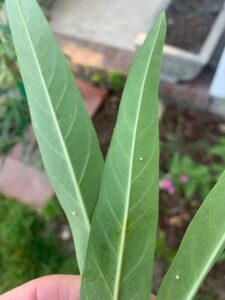
Around March and April, Monarchs lay their eggs on milkweed plants.
Caterpillar
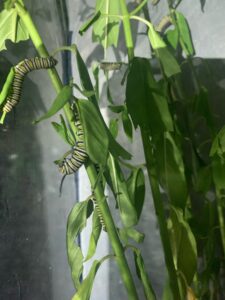
The eggs hatch into baby caterpillars. It takes four days for a caterpillar to hatch out of its egg and the larvae will actually eat its egg as it hatches! The caterpillar will eat (and eat and eat!) and as it begins to grow, it will begin to molt. Once the caterpillar is ready to pupate (transform) they will hang upside down in a j-shape and molt one last time.
Chrysalis
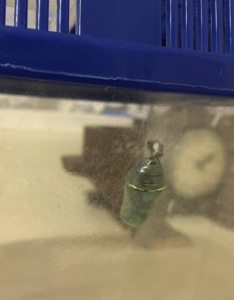
While it may look like nothing is happening during this stage of the life cycle, the caterpillar is going through a rapid change in only ten days!
Emergence
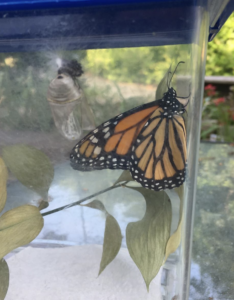
After the ten days in its chrysalis, the butterfly emerges. It takes a few hours from emergence for the wings to become straight and for the butterfly’s wings to dry (they flap them to help dry them). After the monarch’s wings are fully stretched and dried, they are released into to the wild.
This year was Kylie’s first year raising and releasing monarch butterflies. “This year I’ve released 30 or so. Most of them I’ve released at the Zoo since our gardens are full of flowers and milkweed, but I’ve also released some in my garden. Most of my monarchs have been female this year. Henry VIII was my only male! You can tell they’re male if they have the two black dots on their lower wings—these are absent in females.”
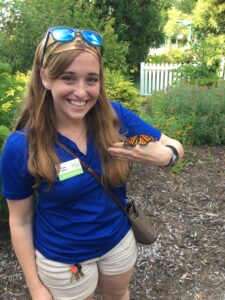
Tara, who has been raising and releasing monarchs since 2018, has released more than 300 butterflies. “We release them in our front yard several hours after they emerge. We sex each butterfly before we release and report our information to Journey North, an organization dedicated to tracking butterfly populations and migratory patterns.”
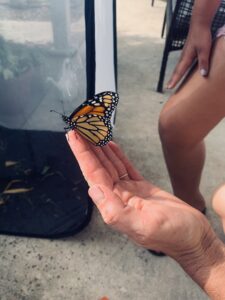
Unfortunately, for the last 20 years, the monarch population has been on a steady decline. This captivating species is now considered threatened due to different environmental factors like climate change and habitat loss.
Many organizations are working hard to maintain the monarch butterfly. The U.S. Fish and Wildlife Service extended the deadline to determine whether monarch butterflies warrant Endangered Species Act (ESA) protection. AZA Safe, a program for AZA-accredited zoos to help spread the message of protecting endangered species, established a program for monarch butterflies in September 2019. The Virginia Zoo is aiming to join the SAFE program in the near future.
There are many different ways to help conservation efforts of protecting monarch butterflies. Planting milkweed and other nectar plants is a great way to help the population. As caterpillars, monarchs primarily eat milkweed. While adult monarch butterflies only feed on nectar, they still love to lay their eggs on milkweeds.
While raising and releasing monarchs can be a great way to help the population, Tara and Kylie recommend that you do your research because the process is a labor of love. “The process is not hard, however, you have to be diligent to maintain the best practices,” said Tara.
Interested in learning how to raise and release butterflies? Kylie recommends that you contact the Butterfly Society of Virginia. “Their volunteers are extremely passionate about butterfly conservation and it is infectious!”
